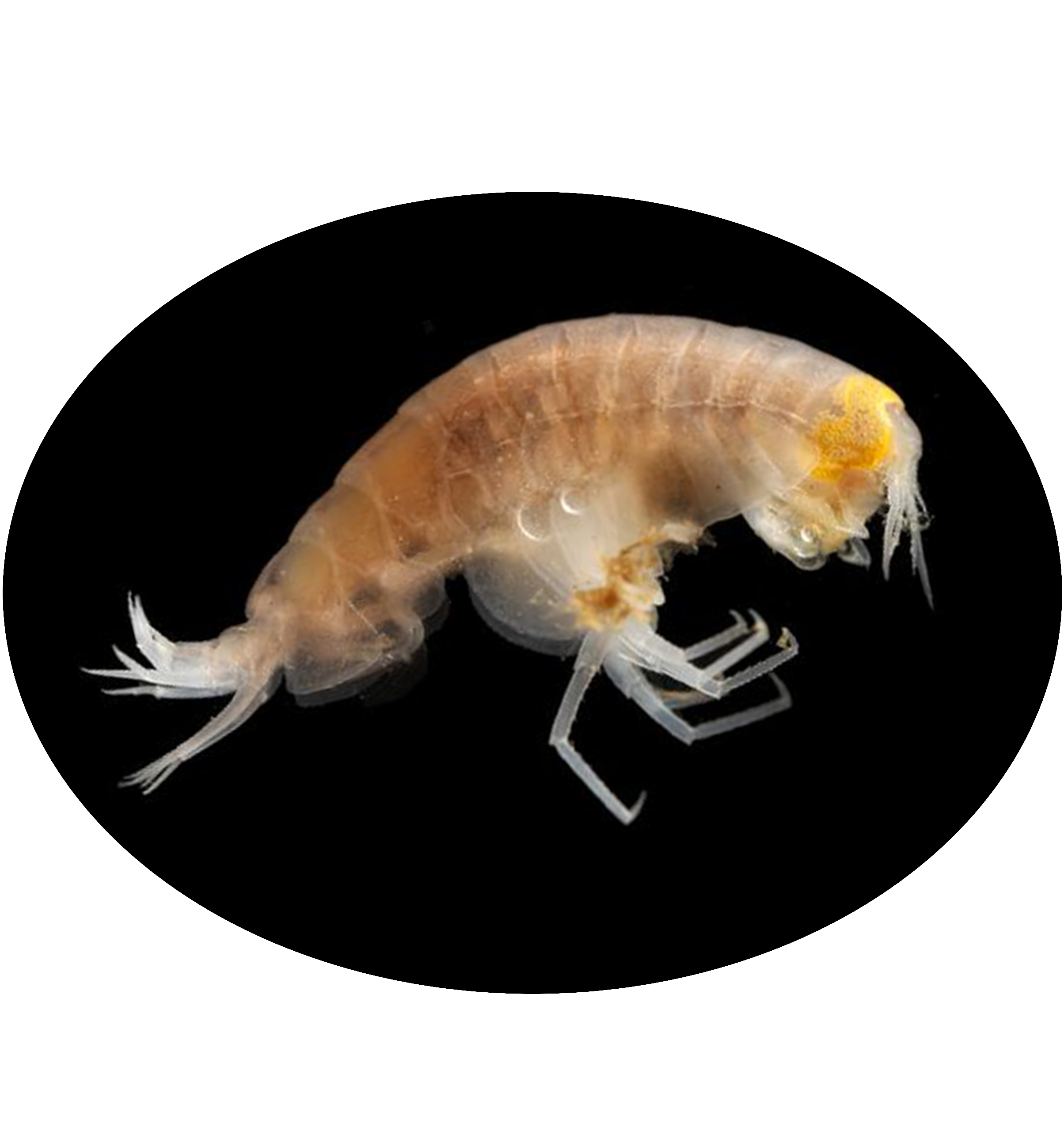
Hirondellea gigas is a species of amphipod crustacean found in the hadal zone of the Pacific Ocean, particularly in the Mariana Trench. It is adapted to extreme deep-sea environments, living at depths exceeding 10,000 meters where pressures are immense and temperatures are near freezing. This species feeds on organic matter that sinks to the ocean floor, playing a crucial role in the deep-sea ecosystem as a scavenger. Its unique adaptations, such as a lightweight exoskeleton and specialized enzymes, allow it to survive and thrive in one of the most extreme habitats on Earth.
Animalia (Kingdom); Arthropoda (Phylum); Crustacea (Subphylum); Multicrustacea (Superclass); Malacostraca (Class); Eumalacostraca (Subclass); Peracarida (Superorder); Amphipoda (Order); Amphilochidea (Suborder); Lysianassida (Infraorder); Lysianassidira (Parvorder); Lysianassoidea (Superfamily); Hirondelleidae (Family); Hirondellea (Genus); Hirondellea gigas (Species)
Tetronychia gigas Birstein & M. Vinogradov, 1955
Philippine Trench from Philippine Sea, Mariana Trench from North Pacific Ocean and Kuril-Kamchatka Trench
| Species | Phylum | Common Name | Ecosystem | Depth | Habitat | NCBI Taxonomy ID |
|---|---|---|---|---|---|---|
| Hirondellea gigas | Arthropoda | - | Deep sea | 6,800-11,000 | Mariana Trench in the northwestern Pacific Ocean | 1518452 |
| Genome Assembly | Genome Size | Assembly level | Released year | WGS accession | Submitter | BioProject | BUSCO completeness (%) | Scaffold/Contig N50 (kb) | GC content (%) | Repeat Rate (%) | Gene Number |
|---|---|---|---|---|---|---|---|---|---|---|---|
| - | 13.92Gb | Chromosome | 2025 | CNA0142381 | - | CNP0005374 | 89.34 | 458,700/466.1 | 38.8 | 72.75 | 27,881 |
| Title | Journal | Pubmed ID |
|---|---|---|
| The amphipod genome reveals population dynamics and adaptations to hadal environment | Cell | 40054448 |
| Gene ID | Description |
|---|---|
| Hgig_17147 | IONOTROPIC RECEPTOR 20A-RELATED |
| Hgig_17148 | DISCOIDIN, CUB, EGF, LAMININ , AND ZINC METALLOPROTEASE DOMAIN CONTAINING |
| Hgig_17149 | |
| Hgig_17150 | TRANSCRIPTASE, PUTATIVE-RELATED-RELATED |
| Hgig_17151 | |
| Hgig_17152 | |
| Hgig_17153 | |
| Hgig_17154 | CLEAVAGE/POLYADENYLATION FACTOR IA SUBUNIT CLP1P |
| Hgig_17155 | |
| Hgig_17156 | PROTEIN CBG27172 |
| Hgig_17157 | |
| Hgig_17158 | |
| Hgig_17159 | KINESIN-RELATED |
| Hgig_17160 | CENTROMERE PROTEIN E |
| Hgig_17161 | KINESIN-RELATED |
| Hgig_17162 | |
| Hgig_17163 | ZINC FINGER BED DOMAIN-CONTAINING PROTEIN 4 |
| Hgig_17164 | NUCLEOPORIN P54 |
| Hgig_17165 | TRANSMEMBRANE GTPASE FZO |
| Hgig_17166 | GLUCOCORTICOID MODULATORY ELEMENT-BINDING PROTEIN |
| Hgig_17167 | GLUCOSE-METHANOL-CHOLINE GMC OXIDOREDUCTASE |
| Hgig_17168 | GLUCOSE-METHANOL-CHOLINE GMC OXIDOREDUCTASE |
| Hgig_17169 | TRANSPOSASE-RELATED |
| Hgig_17170 | KEREN-RELATED |
| Hgig_17171 | RETROVIRUS-RELATED POL POLYPROTEIN FROM TRANSPOSON 412-LIKE PROTEIN-RELATED |
| Hgig_17172 | |
| Hgig_17173 | |
| Hgig_17174 | TRANSPOSABLE ELEMENT-RELATED |
| Hgig_17175 | TRANSPOSABLE ELEMENT TC3 TRANSPOSASE-LIKE PROTEIN |
| Hgig_17176 | |
| Hgig_17177 | |
| Hgig_17178 | UBIQUITIN LIGASE E3 ALPHA-RELATED |
| Hgig_17179 | UBIQUITIN LIGASE E3 ALPHA-RELATED |
| Hgig_17180 | UBIQUITIN LIGASE E3 ALPHA-RELATED |
| Hgig_17181 | ATP SYNTHASE |
| Hgig_17182 | |
| Hgig_17183 | METHYLTRANSFERASE-LIKE PROTEIN 24 |
| Hgig_17184 | NEDD4-BINDING PROTEIN 2 |
| Hgig_17185 | |
| Hgig_17186 | RNA-BINDING MOTIF PROTEIN, X-LINKED 2 |
| Hgig_17187 | |
| Hgig_17188 | RAS LIKE FAMILY 10 MEMBER B-RELATED |
| Hgig_17189 | RAS LIKE FAMILY 10 MEMBER B-RELATED |
| Hgig_17190 | |
| Hgig_17191 | |
| Hgig_17192 | JAK PATHWAY SIGNAL TRANSDUCTION ADAPTOR MOLECULE |
| Hgig_17193 | HAT FAMILY DIMERISATION DOMAINCONTAINING PROTEIN-RELATED |
| Hgig_17194 | NOP14 |
| Hgig_17195 | STRUCTURAL MAINTENANCE OF CHROMOSOMES SMC FAMILY MEMBER |
| Hgig_17196 |

